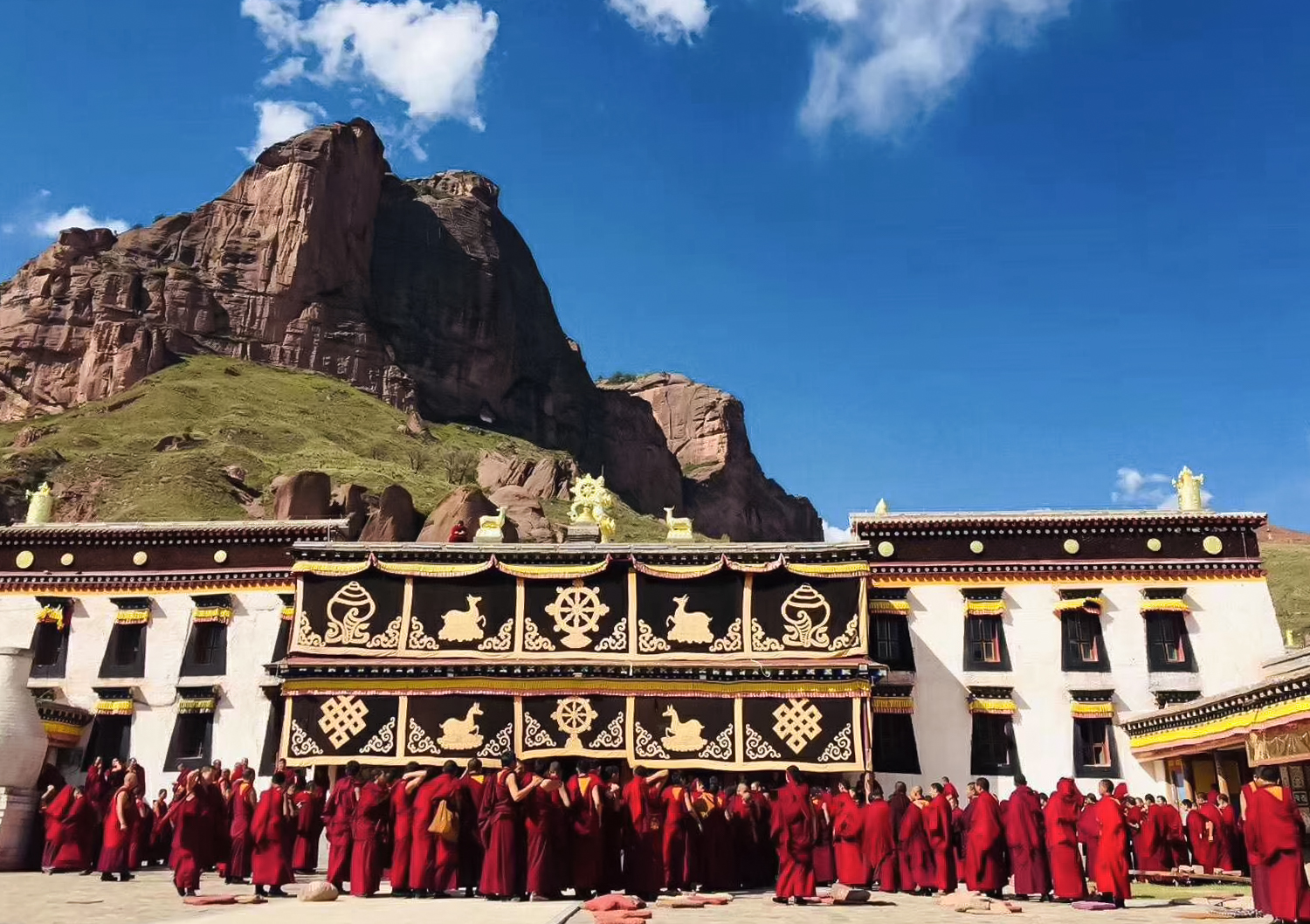Gautama Buddha survived several attempts on his life. What does his life example teach us about impermanence, and preparing for death
Gautama Buddha survived several attempts on his life, more than once from his cousin Devadatta, once from a mass murderer Angulimara — who later became a disciple after he failed — and finally the Enlightened One passed into Nirvana...
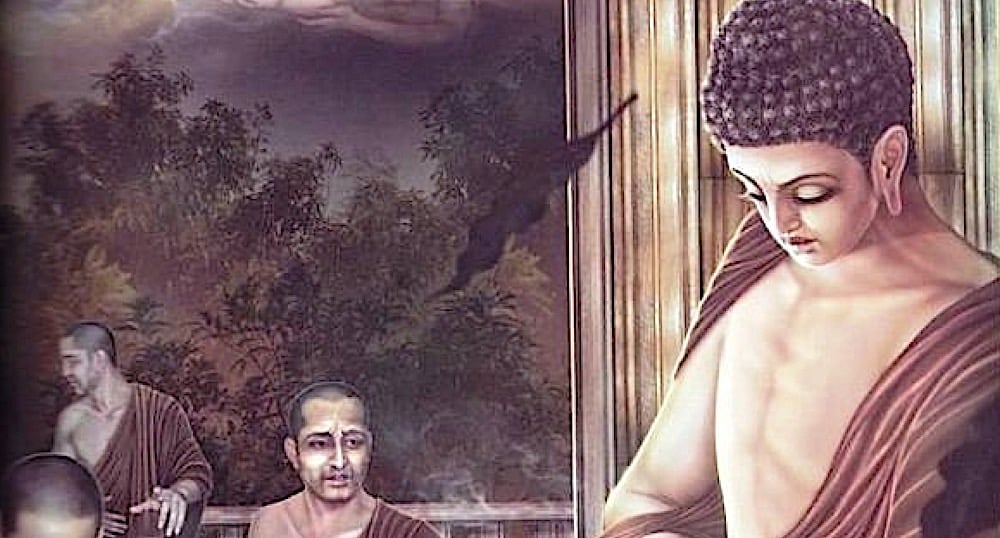
Gautama Buddha survived several attempts on his life, more than once from his cousin Devadatta, once from a mass murderer Angulimara — who later became a disciple after he failed — and finally the Enlightened One passed into Nirvana when he ate tainted food given to him as alms by follower Cunda. His greatest concern, as he passed, was that no one blame Cunda.
By Payal Seth and Tenzin Dakpa
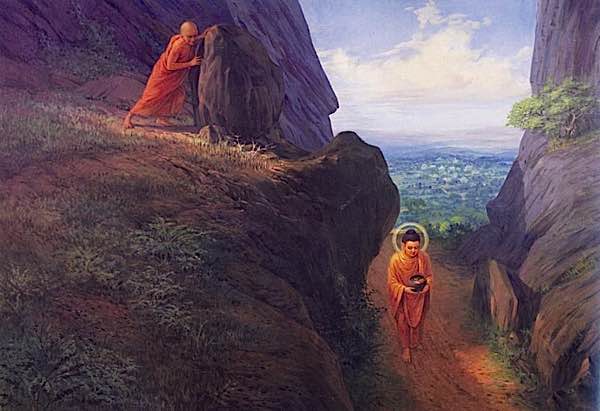 Devadatta unsuccessfully tries to kill Buddha — again — by pushing a boulder.
Devadatta unsuccessfully tries to kill Buddha — again — by pushing a boulder.
Buddha is not the only spiritual teacher who has demonstrated lessons in impermanence and forgiveness of those who attack us. Buddha, as he was passing, explained to his disciples how Cunda was not to be blamed for feeding him tainted food. Jesus when he was crucified, prayed that the perpetrators be forgiven. Guru Tegh Bahadur sacrificed himself to demonstrate compassion.
Death and impermanence are the certainties of life. We all have to face it and it is also the one that we have prepared for the least. In Buddhism, karma is the most important aspect of “dying.” Buddhist practice is, in part, about resolving our negative karma from our life and past lives. If we leave this life blaming others, or feeling anger, or swayed by any of the other “poisons” such as hate, we — at that moment — lose our mindful focus on Bodhichitta and Dharma. Buddha knew that “showing” by example was the greatest of lessons. No amount of eloquent teaching can match the effectiveness of a life example.
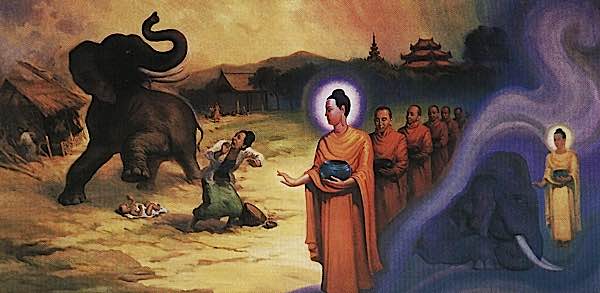 Shakyamuni subdues an elephant with loving kindness and the Abhaya gesture. The elephant was enraged by evil Devadatta.
Shakyamuni subdues an elephant with loving kindness and the Abhaya gesture. The elephant was enraged by evil Devadatta.
So how does one prepare for death? How does one embrace death with equanimity? Teaching by example, Buddha demonstrated compassion for the man responsible for his passing. Jesus forgave his persecutors. Martyrdom is not the point. Compassion, Bohdichitta, and Metta are the lessons of the Great Ones.
Buddha’s life is our example — surviving numerous assassination attempts
Buddha spent decades teaching Dharma and how to achieve the extinguishing of our negative karmas to help us avoid the cycle of samsara. Yet, out of all the 80,000 recorded teachings of the Buddha, no lesson is more eloquent than his life’s example.
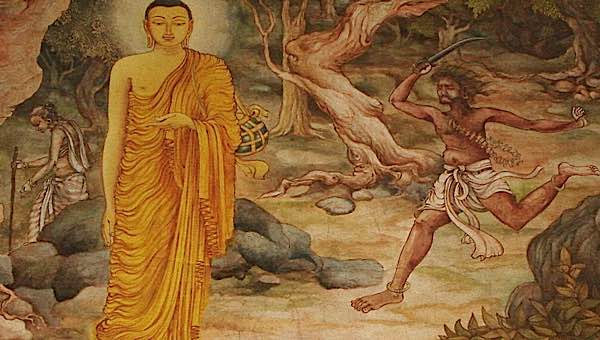 Shakyamuni saves Angulimala from himself. The mass murderer tries to take Buddha as his 1000th victim. When he fails, he falls to Buddha’s feet and asks to be taken as a monk. Although Buddha agrees, Angulimala must endure endless beatings at the hands of his victim’s families. To read the inspiring story of Angulimala, see>>
Shakyamuni saves Angulimala from himself. The mass murderer tries to take Buddha as his 1000th victim. When he fails, he falls to Buddha’s feet and asks to be taken as a monk. Although Buddha agrees, Angulimala must endure endless beatings at the hands of his victim’s families. To read the inspiring story of Angulimala, see>>
For almost as long as Buddha taught, he calmly dealt with calumny — not just from strangers such as teachers and politicians, but from his first cousin Devadatta. Devadatta came to see Buddha as his rival, even an enemy. When Buddha was 72, Devadatta incited a man to stab the Buddha to death. Upon encountering his assassin, Buddha saw through this plan and foiled it with kindness. The assassin upon encountering Buddha became terrified. Buddha addressed him with gentleness and asked him to come closer. The man confessed his plans and asked for forgiveness from the Buddha.
The Buddha forgave him and said,
“For this, O friend, is progress in the discipline of the Noble One, that he who has seen his sin to be sin makes amends for it as is meet, and becomes able in the future to restrain himself therefrom”.
Devadatta’s murderous intent
Taking matters into his own hand, Devadatta even tried to push a huge boulder down a mountain pass, aiming at the Buddha. Thanks to karma, the rock caught between two mountain peaks, and only a splinter hurt Buddha’s foot.
Buddha endured a few more unsuccessful assassination attempts and false accusations with compassion and equanimity — showing throw his own conduct and forgiveness the acts of a Bodhisattva.
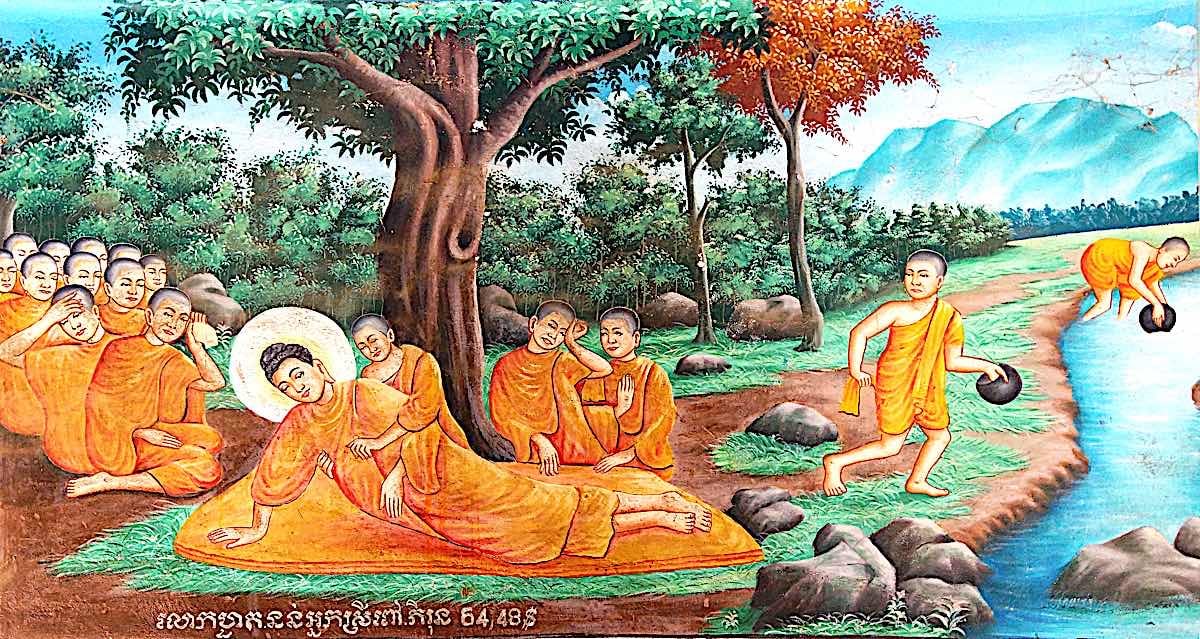 Shakyamuni Buddha passes into Paranirvana after decades of teaching. Even his ending was a lesson in impermanence and an important example.
Shakyamuni Buddha passes into Paranirvana after decades of teaching. Even his ending was a lesson in impermanence and an important example.
Buddha’s nirvana and passing
Buddha ultimately passed due to tainted food. One evening, while wandering for alms he received a meal from Cunda Kammāraputta, a smith.[1] He knew that the food was rotten and would cause him immense harm, yet as a monk, he humbly accepted it — it is impolite to refuse alms — and blessed Cunda for the food. He ate it with equanimity. He endured the consequent sharp pains by practicing what he taught: mindfulness, calmness, and equanimity, Bodhichitta. Buddha, now in pain, knowing he would soon perish, retained his loving-kindness and infinite compassion by ensuring Cunda wouldn’t be blamed for the Buddha’s passing away. In fact, it is Cunda who achieved great merit as the person who, with good intentions, gave Buddha his last meal! This is because intention determines karma.
Buddha asked his closest follower, Ananda, to prepare a place for him to lie down between the two sal trees. He laid down in the lion posture, placing one foot on the other, mindful and clearly aware.
He also asked Ananda to call the people nearby so that they may not be deprived of his last moments.
To the last, Buddha demonstrated with example. As he lay passing, a wanderer happened on the scene, and, desperate, beseeched Buddha to teach him and accept him as a disciple.
In spite of the pain that the Buddha was in and his circumstances — solely driven by his compassion for this wanderer — he taught him, and asked Ananda to ordain him. He is known to be the last disciple of Lord Buddha.
His last words to the congregation gathered around were about the impermanence of life:
“I declare to you: all conditioned things are of a nature to decay- strive on untiringly”.
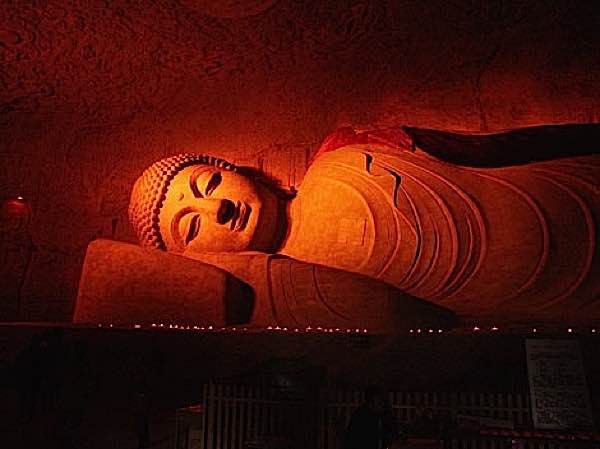 Buddha passed peacefully into paranirvana — with no fear.
Buddha passed peacefully into paranirvana — with no fear.
His last words were also spoken for the benefit of the people. And then the Enlightened One passed away in meditation. True to Buddha’s teachings and the values he practiced himself throughout his life, every incident preceding Buddha’s death was laden with overwhelming compassion for other people. He taught no only with words — but with deeds.
Buddha told his disciples before dying, “This too. You too.”
He meant that if death can happen to Buddha, it will also happen to all of us.
He demonstrated that we are the same as him. He demonstrated through his life that we should spend our lives diligently and that we should prepare for impermanence.
In the wise words of the Dalai Lama,
“We cannot hope to die peacefully if our minds have been agitated by emotions like anger, attachment, or fear… So if we wish to die well, we must learn how to live well: Hoping for a peaceful death, we must cultivate peace in our mind, and in our way of life”.
The example of others
When Jesus was crucified, he prayed for his perpetrators, “Father, forgive them, for they do not know what they are doing.” Even in his last moment, he didn’t pray to be saved, but only for the forgiveness of enemies.
Likewise, saints and spiritual leaders of many spiritual paths are often martyrs who died with exemplary courage and for the sake of compassion.
Most of us know people who are heroic examples of this compassionate sacrifice.
One such person was my grandfather, V.P Bhasin. He was a man of his word, a reservoir of kindness, and a constant seeker of knowledge. He had devoted all his actions to his family and the community. His unique nature of remaining calm and at the same time, full of joy, has taught us the precious lesson of never losing hope even in the most difficult of circumstances. One morning, my grandfather left alone for the holy city of Haridwar, India. He settled himself in a hotel at night, and the next morning, he ordered tea. When the server came, he had passed away, sitting perfectly still in his chair. His death showed how he chose to shed his body in a spiritually vibrant land, away from his loved ones, so that emotions and the need for clinging to life don’t arise. Not only had he anticipated his death but had managed to pass away with grace.
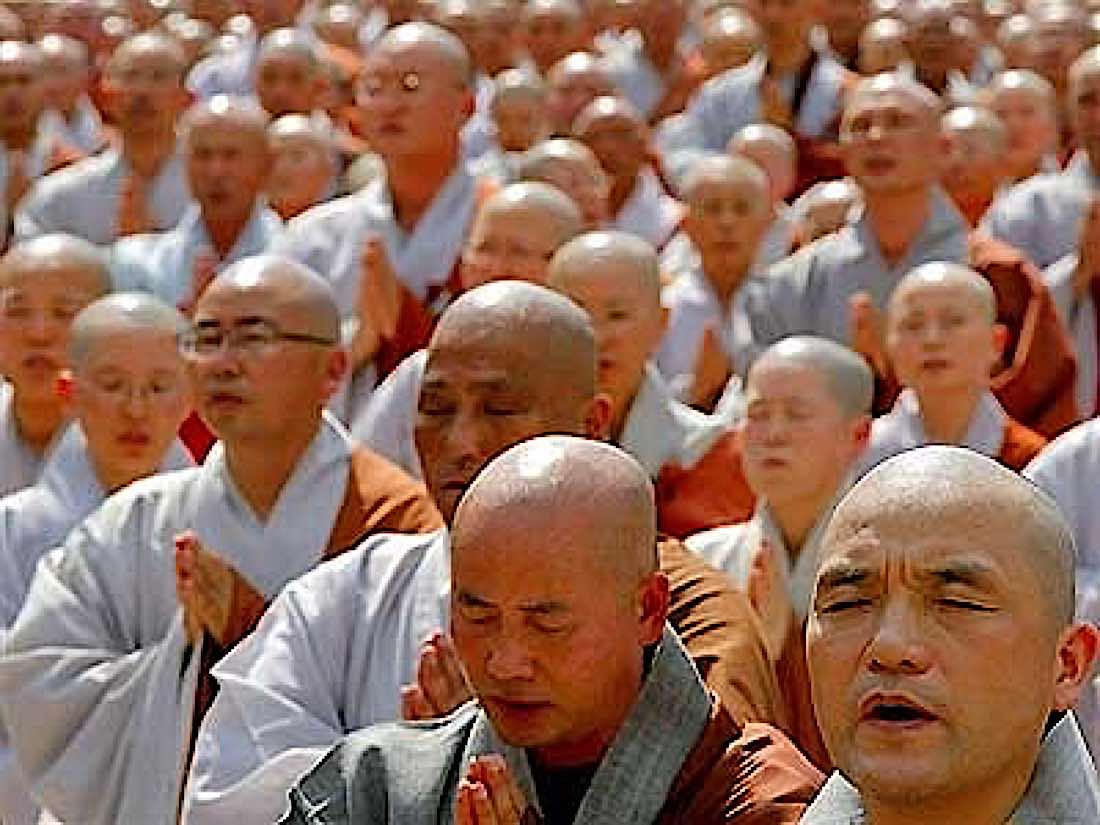 Monks in Japan on Paranirvana Day, when we celebrate Buddha’s final teaching.
Monks in Japan on Paranirvana Day, when we celebrate Buddha’s final teaching.
Buddha’s final teaching
The beautiful final words of the Buddha to his monks from his Last Admonition and Teaching — inspiring them to continue the Dhamma by reminding them of the four foundations and the noble Eightfold Path he spent his lifetime teaching (from the Maha-parinibbana Sutta):
“And what, bhikkhus, are these teachings? They are the four foundations of mindfulness, the four right efforts, the four constituents of psychic power, the five faculties, the five powers, the seven factors of enlightenment, and the Noble Eightfold Path. These, bhikkhus, are the teachings of which I have direct knowledge, which I have made known to you, and which you should thoroughly learn, cultivate, develop, and frequently practice, that the life of purity may be established and may long endure, for the welfare and happiness of the multitude, out of compassion for the world, for the benefit, well being, and happiness of gods and men.
“My years are now full ripe, the life span left is short. Departing, I go hence from you, relying on myself alone. Be earnest, then, O bhikkhus, be mindful and of virtue pure! With firm resolve, guard your own mind! Whoso untiringly pursues the Dhamma and the Discipline Shall go beyond the round of births and make an end of suffering.”
References:
Preparing for Death by Arun Shourie
The Tibetan Book of Living and Dying by Sogyal Rinpoche
Cunda Kammāraputta Sutta
Maha-parinibbana Sutta
Payal Seth is an economist researcher at Tata-Cornell Institute, Cornell University, New York, USA.

 Astrong
Astrong 








